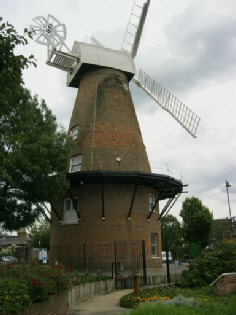

Make a point of visiting us weekly!


Local Government
Rochford District Council
News Bulletin Page
Local artist brings Rayleigh Windmill back to life
ORIGINAL NEWS BULLETIN (date: 22 June 2011)
The Rayleigh Windmill’s exciting summer of art exhibitions starts today (June 22) with an art installation by local artist Max Dolding.
The installation promises to be a spectacular event with the inside of the Windmill taken over with sound and projected images to recreate the inner workings of a windmill.
Max, who comes from Rayleigh, has filmed the inside of a working windmill in Norfolk and edited a series of sequences which are projected onto a backdrop on the second floor of the Rayleigh Windmill. The sound and light exhibition aims to give visitors a sense of the sights and sounds of how the Windmill may have looked 200 years ago.
Artist Max Dolding said: “The ‘space’ at Rayleigh Windmill has been lovingly restored for its current use, but I wanted to conjure up an image of what the original mill must have been like 200 years ago.I visited Denver Mill in Norfolk which still works, producing flour for an in-house bakery and serving the bread and cakes in the shop and restaurant. While I was there, the mill was described to me as ‘a grumpy old lady’ who is basically happy, but moans and groans as the wind catches her sails. I filmed sequences of the mill as it was working on a day of fairly light winds and recorded a soundtrack starting from silence, beginning with slow creaking and building to a rhythmic beat which is quite hypnotic after a while.The idea of the film is to project it onto a backdrop of the Rayleigh Windmill to give people an idea of how it may have looked when it worked hundreds of years ago.There are no combustion engines, electronics or computers involved, just wind and gravity. I hope people who come to look at the exhibition enjoy my effort to recreate what Rayleigh Windmill may have looked like in its heyday and are inspired to visit real working windmills and wonder at their sights and sounds.”
Max Dolding’s Installation “Recreating a working windmill environment” exhibition starts on Wednesday 22 June at the Rayleigh Windmill and runs until 23 July. The Windmill is open on Wednesdays (between 10am and 1pm), Saturdays (1pm – 4pm) and Sundays (1pm-4pm).
ORIGINAL NEWS BULLETIN (date: 22 June 2011)
The Rayleigh Windmill’s exciting summer of art exhibitions starts today (June 22) with an art installation by local artist Max Dolding.
The installation promises to be a spectacular event with the inside of the Windmill taken over with sound and projected images to recreate the inner workings of a windmill.
Max, who comes from Rayleigh, has filmed the inside of a working windmill in Norfolk and edited a series of sequences which are projected onto a backdrop on the second floor of the Rayleigh Windmill. The sound and light exhibition aims to give visitors a sense of the sights and sounds of how the Windmill may have looked 200 years ago.
Artist Max Dolding said: “The ‘space’ at Rayleigh Windmill has been lovingly restored for its current use, but I wanted to conjure up an image of what the original mill must have been like 200 years ago.I visited Denver Mill in Norfolk which still works, producing flour for an in-

(One of our comments has often been that we don’t cover events outside Rochford - but we do cover those that we’re told about and which we feel Rochford residents might be interested in.)
On the right is the Press Release as it came to us in June. Today (23rd July) my wife said, “I’ve got to go over to Rayleigh. Do you want to come?”
“I think there’s an exhibition at the windmill, we could drop in there as well,” I ventured.
On the right is the Press Release as it came to us in June. Today (23rd July) my wife said, “I’ve got to go over to Rayleigh. Do you want to come?”
“I think there’s an exhibition at the windmill, we could drop in there as well,” I ventured.
Thus at 3.30pm, half an hour before closing on the last day, we climbed the stairs of the windmill to view this “exhibition”. Arriving two floors up, in this darkened room we found Max, and on one wall was a film running showing the inner workings of a windmill.
One of the things we have repeated over the months is our conviction that we don’t know what is happening around us. In this case it was our own fault!
If you never got round to visiting the mill and seeing these workings (complete with sounds) you missed a superb experience. In another wall, in a window recess, a make- believe window had the sails passing by every few seconds - very realistic.
While we watched, Max gave us a running commentary of what the film was showing - incredible! The size of the timbers and wheels in this filmed working windmill in Denver, Norfolk, were enormous.
I confess when we first loaded the Press Release I was not impressed - a windmill? Having seen it, the response of both my wife and I was, “Wow! That’s amazing!”
So thank you to Max and thank you to the Council for putting it on. If you missed it - shame, you missed a great learning experience.
Below we reproduce Max’s notes which were handed to each visitor which we’re sure he won’t mind us reproducing here, for you to see his thinking behind this project.
One of the things we have repeated over the months is our conviction that we don’t know what is happening around us. In this case it was our own fault!
If you never got round to visiting the mill and seeing these workings (complete with sounds) you missed a superb experience. In another wall, in a window recess, a make-
While we watched, Max gave us a running commentary of what the film was showing -
I confess when we first loaded the Press Release I was not impressed -
So thank you to Max and thank you to the Council for putting it on. If you missed it -
Below we reproduce Max’s notes which were handed to each visitor which we’re sure he won’t mind us reproducing here, for you to see his thinking behind this project.
Artist's statement:
When I was offered the exhibition space at Rayleigh windmill, I had a very open mind on what to create. My practice is not fixed in one medium and I enjoy the challenge of 'making for a space'.
The 'space' at Rayleigh windmill has certainly been lovingly restored for its current use. BUT, the more I have visited, the more disappointed I have become that every trace of the original working windmill has been removed from the building. The picture postcard view from outside is nice, but does it conjure up what the original mill must have been like 200 years ago?
So, I decided to seek out a working windmill and found one at Denver Mitt in Norfolk where Mark Abel allowed me free access to drink in the atmosphere in his windmill, originally built in 1825 and now restored in its original state with original working machinery, largely constructed of wood and actually working, producing flour, using the flour in the in-
I spent a day becoming hypnotised by the sights and sounds over the four floors of real activity. Mark described the old mill as a 'grumpy old lady', who is basically happy but moans and groans and creeks as the wind catches her sails. The sails have canvas inserts which have to be adjusted (by hand) for the strength of the wind and the whole sail construction moves around with the cap on metal wheels. The construction of the building has to be robust to withstand the force of the wind but also flexible enough to move with the ever changing forces.
My film includes edited sequences at various stages of what was a day of fairly light winds, meaning I recorded the start up from silence, beginning with slow creaking and building to a rhythmic beat which is quite hypnotic after a while. Every now and then you can discern a metallic squeak as the cap revolves with the change in wind direction.
Eventually, Mark excitedly announced that the 'right sort of wind' had blown up - meaning it was of sufficient strength and steadiness to allow some milling - and resulting sequences recorded on the grinding floor where the millstones are installed reveals yet another depth of rich soundscape. Down one more floor to the meal floor, where the ground flour falls by gravity, the sounds from above are muted and quite restful.
There are no combustion engines, electronics or computers involved -
If you get a chance, please visit a real working windmill and wonder at the sights and sounds. Meanwhile, I hope you enjoy my effort to help you recreate what Rayleigh windmill might have been like in its heyday.
- Max Dolding June 2011
www.maxdolding.net
max.dolding@me.com
07799 414 270
When I was offered the exhibition space at Rayleigh windmill, I had a very open mind on what to create. My practice is not fixed in one medium and I enjoy the challenge of 'making for a space'.
The 'space' at Rayleigh windmill has certainly been lovingly restored for its current use. BUT, the more I have visited, the more disappointed I have become that every trace of the original working windmill has been removed from the building. The picture postcard view from outside is nice, but does it conjure up what the original mill must have been like 200 years ago?
So, I decided to seek out a working windmill and found one at Denver Mitt in Norfolk where Mark Abel allowed me free access to drink in the atmosphere in his windmill, originally built in 1825 and now restored in its original state with original working machinery, largely constructed of wood and actually working, producing flour, using the flour in the in-
I spent a day becoming hypnotised by the sights and sounds over the four floors of real activity. Mark described the old mill as a 'grumpy old lady', who is basically happy but moans and groans and creeks as the wind catches her sails. The sails have canvas inserts which have to be adjusted (by hand) for the strength of the wind and the whole sail construction moves around with the cap on metal wheels. The construction of the building has to be robust to withstand the force of the wind but also flexible enough to move with the ever changing forces.
My film includes edited sequences at various stages of what was a day of fairly light winds, meaning I recorded the start up from silence, beginning with slow creaking and building to a rhythmic beat which is quite hypnotic after a while. Every now and then you can discern a metallic squeak as the cap revolves with the change in wind direction.
Eventually, Mark excitedly announced that the 'right sort of wind' had blown up -
There are no combustion engines, electronics or computers involved -
If you get a chance, please visit a real working windmill and wonder at the sights and sounds. Meanwhile, I hope you enjoy my effort to help you recreate what Rayleigh windmill might have been like in its heyday.
-
www.maxdolding.net
max.dolding@me.com
07799 414 270
What you Missed? How a windmill came to life!